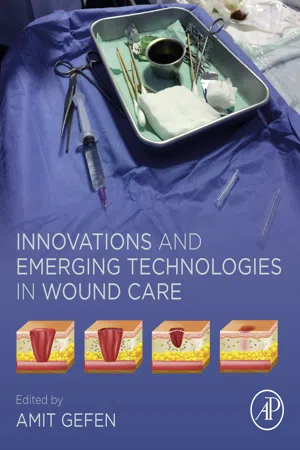
Innovations and Emerging Technologies in Wound Care
Amit Gefen
- 464 Seiten
- English
- ePUB (handyfreundlich)
- Über iOS und Android verfügbar
Innovations and Emerging Technologies in Wound Care
Amit Gefen
Über dieses Buch
Innovations and Emerging Technologies in Wound Care is a pivotal book on the prevention and management of chronic and non-healing wounds. The book clearly presents the research and evidence that should be considered when planning care interventions to improve health related outcomes for patients. New and emerging technologies are discussed and identified, along with tactics on how they can be integrated into clinical practice. This book offers readers a bridge between biomedical engineering and medicine, with an emphasis on technological innovations. It includes contributions from engineers, scientists, clinicians and industry professionals.
Users will find this resource to be a complete picture of the latest knowledge on the tolerance of human tissues to sustained mechanical and thermal loads that also provides a deeper understanding of the risk for onset and development of chronic wounds.
- Describes the state-of-knowledge in wound research, including tissue damage cascades and healing processes
- Covers all state-of-the-art technology in wound prevention, diagnosis, prognosis and treatment
- Discusses emerging research directions and future technology trends in the field of wound prevention and care
- Offers a bench-to-bedside exploration of the key issues that affect the practice of prevention and management of non-healing wounds
Häufig gestellte Fragen
Information
Mathematical models of healing of burns
Abstract
Keywords
1. Introduction
2. Biological mechanisms
Inhaltsverzeichnis
- Cover image
- Title page
- Table of Contents
- Copyright
- Contributors
- Foreword
- Chapter 1. Mathematical models of healing of burns
- Chapter 2. Ultrasound and magnetic resonance imaging methods for determining pressure injury risk
- Chapter 3. Computational modeling of the thin muscle layer, panniculus carnosus, demonstrates principles of pressure injury and prophylactic dressings
- Chapter 4. Lower leg compression and its biomechanical effects on the soft tissues of the leg
- Chapter 5. Real-time computer modeling in prevention of foot pressure ulcer using patient-specific finite element model and model order reduction techniques
- Chapter 6. Bioengineering studies of cell migration in wound research
- Chapter 7. Heel ulcers: investigating injurious tissue load thresholds in humans, based on a patient-specific computational heel model
- Chapter 8. Shape memory polymers for design of smart stocking
- Chapter 9. Emerging electroporation-based technologies for wound care
- Chapter 10. Deep tissue pressure injury: a clinical perspective regarding a condition that evolves under the skin
- Chapter 11. Skin health and integrity
- Chapter 12. Animal models in chronic wound healing research: for innovations and emerging technologies in wound care
- Chapter 13. Smart technologies in wound prevention and care
- Chapter 14. Method for improving skin color accuracy of three-dimensional printed training models for early pressure ulcer recognition
- Chapter 15. Effects of friction and pressure on skin in relation to pressure ulcer formation
- Chapter 16. Silver–enzyme hybrids as wide-spectrum antimicrobial agents
- Chapter 17. Biomechanical aspects of skin aging—the risk of skin breakdown under shear loading increases with age
- Chapter 18. Developing standard test methods for assessment of medical devices in the fields of wound prevention and care
- Index